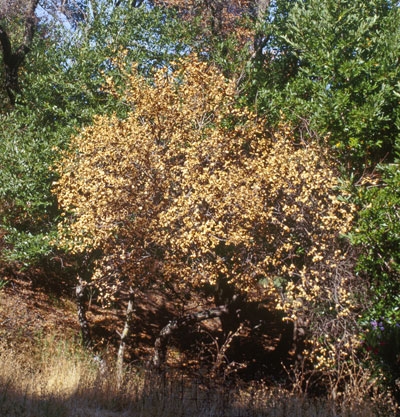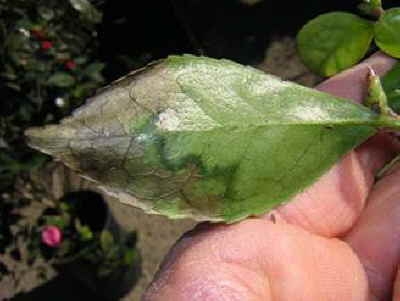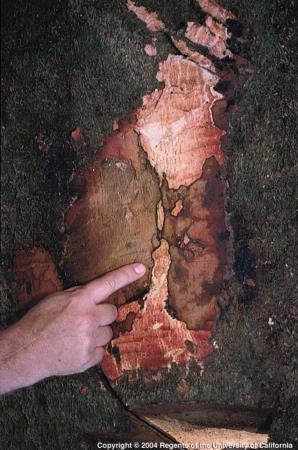Posts Tagged: Phytophthora ramorum
UC Berkeley scientist surprised by SOD incidence
The Forest Pathology and Mycology Laboratory at UC Berkeley used 10,000 tree and plant samples collected by 500 citizens between April and June to document a dramatic increase in the Sudden Oak Death infection rate from Napa to the Carmel Valley, according to the San Francisco Chronicle.
"We found that the number of positives were double and in some cases triple what they were last year," said Matteo Garbelotto, the UC Berkeley forest pathologist who organizes the annual surveys. "We were surprised. That was a big jump."
Old Farmer's Almanac: 220 years of useful advice
Sam McManis, Sacramento Bee
The Sacramento Bee ran a feature story yesterday about the 220-year-old "Old Farmer's Almanac." The article said that most readers of the publication these days are not farmers. When the Bee contacted the California Farm Bureau Federation to find farmers who use the almanac as part of their work or even just for entertainment, its spokeswomen suggested asking Chuck Ingels, farm advisor and director of UC Cooperative Extension in Sacramento County.
"I honestly have never looked at the almanac, but I've seen it on bookshelves," Ingels said. "It's never mentioned by the farmers I'm in contact with."

Dramatic increase in Northern California Sudden Oak Death.
Sudden Oak Death appears in San Francisco's Presidio
A coast live oak tree on the southeastern edge of the Presidio National Park in San Francisco was found to have Sudden Oak Death disease, according to an article in the San Francisco Chronicle.
The disease was believed to have made its way to the tree from an ornamental plant at a nearby home, reported Matteo Garbelotto of UC Berkeley's Forest Pathology and Mycology Laboratory. Scientists are concerned about the find because it means the microbe escaped from an ornamental and infected a wild tree despite an intensive nationwide effort to control the disease in nurseries.
“I was surprised by the finding because the Presidio is located in an urban setting, far from any other known infestation,” Garbelotto was quoted in a news release from the California Oak Mortality Task Force. “With a few exceptions, all known infestations are close to oak woodlands or redwood forests.”
The infected oak is one of the few native trees in the Presidio, wrote Chronicle reporter Peter Fimrite. Of the 60,000 trees in 300-acre park, only about 200 are native oaks.
The infected tree was discovered by an arborist for the Presidio Trust. The Garbelotto lab took samples, which showed a strain of sudden oak death that is normally seen only in ornamental plants. Laboratory workers tested other trees, plants and soil samples from the same area, but no evidence of the pathogen was found.

Camellia leaf infected with the pathogen that causes Sudden Oak Death.
Berkeley lab tracks Sudden Oak Death with citizen help
Scientists at UC Berkeley are using tree and plant samples collected by citizens over the past two years to document Bay Area infestations of Sudden Oak Death, reported the San Francisco Chronicle.
"Last year we had about 240 participants and collected over 1,000 samples. These results were placed on a map so people can see where the positives are," UC Berkeley forest pathologist Matteo Garbelotto was quoted. "This is part of the solution. If we educate and involve individual property owners, we can make a really big difference."
The UC survey documents the following SOD spread:
- In Atherton, Oakland, Hercules and Mill Valley
- In Hercules-Pinole area, Orinda, Moraga and in Redwood Regional Park, Wildcat Canyon and Tilden Park
- Creeping toward south Oakland
- Recolonizing the Berkeley campus after it was thought to have been eliminated nine years ago
- Moving southward and eastward along the Peninsula, infesting Woodside and Los Altos
- All over Tamalpais Valley in Marin County
- West of Healdsburg and Windsor in Sonoma County
- In several trees on the edge of Carmel Valley Village

Discoloration characteristic of infection by Phytophthora ramorum, which causes SOD.
Volunteers battle Sudden Oak Death
To better understand the extent of sudden oak death in California, UC Berkeley professor Mateo Garbelotto is enlisting volunteers in "SOD blitzes" to scour neighborhoods and wildlands for symptoms of the devastating disease, according to a story in the Oakland Tribune.
Sudden oak death, caused by a fungus Phytophthora ramorum, has resulted in widespread dieback of coast live oak, California black oak, Shreve oak, tan oak and canyon live oak in Central and Northern California and Oregon coastal areas.
The Oakland Tribune article, written by Jonathon Morales, said the blitz isn't comprehensive or scientific, but Garbelotto believes the volunteers' efforts are helpful. The SOD blitzes inform and educate the community about Sudden Oak Death, get locals involved in detecting the disease, and produce detailed local maps of disease distribution."If you were to think, 'Oh, I know where sudden oak death is' and you're using data that was produced two years ago, probably you actually don't have a good idea where it is," Garbelotto was quoted.
The blitzes also benefit property owners by letting them know whether their own trees are infected. If detected early, Garbelotto said, there's a chance a property owner can save the tree.
Blitzes are scheduled for April and May. Dates, locations, contact information and reports on previous blitzes are on Garbelotto's Forest Pathology and Mycology Lab Web site.

A Big Sur tan oak that succumbed to sudden oak death.
Saving the forest by cutting down trees
It's heart wrenching, but forest researchers have found that cutting down bay laurel trees can make a woodland a healthier environment for beloved oaks. The bay laurel trees are carriers of the pathogen Phytophthora ramorum. If the bacteria spreads to oaks, it causes a disease called Sudden Oak Death.
Lisa Kreiger of the San Jose Mercury-News reported that "emergency surgery" is taking place in the Santa Cruz Mountains to extricate bay laurels and give ancient and majestic native California oaks a better chance at survival.
UC Berkeley Cooperative Extension forest pathologist Matteo Garbelotto has observed that removal of bay laurels in a 10- to 20-yard radius of an oak doesn't eliminate the pathogen, but lowers its presence — so a potentially heavy attack is turned into a moderate one, the story said.
"These moderate attacks are less likely to result in an oak infection," Garbelotto was quoted in the article, which also appeared in the Monterey Herald and the Oroville Mercury Register.
Thinning the forest is expected to stem the spread of Sudden Oak Death, but it won't stop it. Although the vast majority of infections come from adjacent trees, the scientists say spores can also travel long distances by wind or creek or by dirt on hiking boots.
Nevertheless, UC Davis forest pathologist David Rizzo told the reporter he believes removing bay laurels is "a great idea.""There are relatively few management options for the disease in wildland areas," Rizzo was quoted. "Stand manipulation is the primary tool we have."
UC Cooperative Extension offers extensive information on Sudden Oak Death. For articles, pictures and links, see the Sudden Oak Death media kit.

California bay laurel leaves and flowers.

